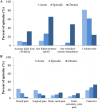Cohort profile: development and characteristics of a retrospective cohort of individuals dispensed prescription opioids for non-cancer pain in British Columbia, Canada
- PMID: 33849849
- PMCID: PMC8051385
- DOI: 10.1136/bmjopen-2020-043586
Cohort profile: development and characteristics of a retrospective cohort of individuals dispensed prescription opioids for non-cancer pain in British Columbia, Canada
Abstract
Purpose: Prescription opioids (POs) are widely prescribed for chronic non-cancer pain but are associated with several risks and limited long-term benefit. Large, linked data sources are needed to monitor their harmful effects. We developed and characterised a retrospective cohort of people dispensed POs.
Participants: We used a large linked administrative database to create the Opioid Prescribing Evaluation and Research Activities cohort of individuals dispensed POs for non-cancer pain in British Columbia (BC), Canada (1996-2015). We created definitions to categorise episodes of PO use based on a review of the literature (acute, episodic, chronic), developed an algorithm for inferring clinical indication and assessed patterns of PO use across a range of characteristics.
Findings to date: The current cohort includes 1.1 million individuals and 3.4 million PO episodes (estimated to capture 40%-50% of PO use in BC). The majority of episodes were acute (81%), with most prescribed for dental or surgical pain. Chronic use made up 3% of episodes but 88% of morphine equivalents (MEQ). Across the acute to episodic to chronic episode gradient, there was an increasing prevalence of higher potency POs (hydromorphone, oxycodone, fentanyl, morphine), long-acting formulations and chronic pain related indications (eg, back, neck, joint pain). Average daily dose (MEQ) was similar for acute/episodic but higher for chronic episodes. Approximately 7% of the cohort had a chronic episode and chronic pain was the characteristic most strongly associated with chronic PO use. Individuals initiating a chronic episode were also more likely to have higher social/material deprivation and previous experience with a mental health condition or a problem related to alcohol or opioid use. Overall, these findings suggest our episode definitions have face validity and also provide insight into characteristics of people initiating chronic PO therapy.
Future plans: The cohort will be refreshed every 2 years. Future analyses will explore the association between POs and adverse outcomes.
Keywords: epidemiology; mental health; pain management; public health.
© Author(s) (or their employer(s)) 2021. Re-use permitted under CC BY-NC. No commercial re-use. See rights and permissions. Published by BMJ.
Conflict of interest statement
Competing interests: None declared.
Figures



References
-
- Canadian Institute for Health Information . Opioid prescribing in Canada: how are practices changing. Available: https://www.cihi.ca/sites/default/files/document/opioid-prescribing-cana...
Publication types
MeSH terms
Substances
Grants and funding
LinkOut - more resources
Full Text Sources
Other Literature Sources
Medical
